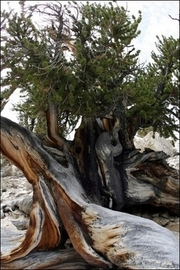Scattered on a remote mountainside of eastern California, these gnarled, twisted specimens are the oldest living organisms on Earth, the most senior among them some 4,700 years old.

|
| ©Signs of the Times |
| Ancient bristlecone pine trees are seen 13 September 2007 in the White Mountains of the Inyo National Forest near Bishop, California. |
If the mere sight of trees that pre-date the ancient Pyramids of Giza is not enough to take the breath away, the hour-long trek to reach them is: these natural wonders are found at a rarified altitude of 3,300 meters.
The bristlecone's astounding durability is partly explained by the harsh climate that they have endured throughout the ages, according to Patti Wells, a US Forest Service naturalist, who has studied the trees for 37 years.
In the summer, the trees bask in temperatures of 25 degrees Celsius, but in winter they are frozen in bone-chilling sub-zero temperatures that can reach minus 30 degrees. Roaring winds of 320 kph (200 mph) pummel the forest, which is also blanketed in snow up to three meters deep.
Only the bristlecone is able to withstand such extreme conditions, botanists say. The reasons are partly to do with the tree's unique make-up and unforgiving location.
Because the trees grow slowly, they have developed an impervious resinous wood, protecting them from insect infestations and mushrooms. The high altitude of the forest also means that potentially devastating fires in the region don't have as much oxygen to feed them, Wells said.
At first glance bristlecone pines often appear to be dead. As the tree ages outer layers of bark die, leaving only a strip of connective tissue stretching from the roots to the few branches that remain alive. The deadwood of "Pinus Longevae" is so solid that it does not rot.
Yet despite the bristlecone's proven resilience to the elements, park officials are more wary of the dangers to the trees posed by man.
The numbers of tourists who come to visit the forest every year are relatively small -- around 60,000 a year -- and forestry officials want to keep it that way.
"We don't make any effort to make it well known," Wells said. "We don't want it to become like Yosemite because it would be damaged."
The location of the oldest tree in the forest, "Methuselah", said to be over 5,000 years old, is kept secret in order to protect it. It follows an incident in 1964 when another tree, "Prometheus," was cut down by a geologist.
The fact that the trees date back several millennia have also enabled scientists to make significant improvements in the field of dendrochronology, or the study of tree rings.
Regarded as the most reliable measure of dating, where one tree ring corresponds to one year, it has allowed scientist to re-calibrate the common carbon dating scale known as "Carbon 14."
Several historical doctrines, such as the notion that all civilization began in ancient Mesopotamia, have been invalidated as a result of the improvements to the scale based on studies of the bristlecone.



Comment: Mike Baillie in the book Exodus to Arthur: Catastrophic Encounters With Comets uses research in the field of dendrochronology and specific information from tree ring samples of the bristlecone pine to build the case that earth is regularly visited by cyclical catastrophies from space.
Laura Knight-Jadczyk's essay 'Independence Day' includes information from Baillie's book and provides further research and detail on the subject.